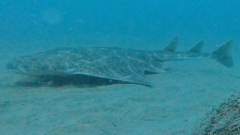What Happens When You Encounter an Endangered Shark in the Bay?

Rarest Shark Captured on Camera in Cardigan Bay: A Conservation Milestone
The marine world never ceases to amaze us, especially when it comes to the stunning biodiversity that exists beneath the waves. Recently, an extraordinary event took place in Cardigan Bay, where one of the world's rarest sharks, the angel shark, was captured on camera for the first time in four years. This remarkable sighting has ignited excitement among marine conservationists and researchers alike. Sarah Perry, a marine conservation and research manager with the Wildlife Trust of South and West Wales, expressed her thrill at this "rare and exciting encounter" with the angel shark, a species that has been classified as critically endangered.
The angel shark, known scientifically as *Squatina squatina*, is a fascinating species that lives and hunts on the seabed. Once common across the eastern Atlantic and Mediterranean seas, its population has sharply declined due to various human-induced threats. These include habitat disturbance, accidental fishing catches, and the impacts of climate change. The recent sighting in Cardigan Bay, documented through an underwater camera set up to study local bottlenose dolphins, is not just an exciting discovery; it serves as a vital reminder of the importance of marine conservation efforts in protecting these endangered species.
The Angel Shark: A Closer Look
Angel sharks are often referred to as "flat sharks" due to their unique body shape, which allows them to blend seamlessly into their surroundings. This camouflage helps them ambush prey, primarily consisting of various fish species. They are bottom-dwellers, spending most of their time lying flat on the seabed, making them difficult to spot for both predators and researchers.
As a result of their elusive nature and the decline in their population, angel sharks have become a symbol of the fragility of marine ecosystems. Their presence in Cardigan Bay indicates that this region may serve as a crucial habitat for their recovery, especially considering that experts have noted similar sightings in recent years. A juvenile angel shark was previously recorded in September 2021, highlighting a potential trend that could lead to a resurgence in their numbers if protective measures are successfully implemented.
The Importance of Conservation Efforts
The sighting of the angel shark comes at a pivotal moment, as discussions are underway in the Senedd and UK government about banning bottom trawling in marine protected areas. Bottom trawling is a fishing method that involves dragging heavy nets across the seabed, resulting in significant habitat destruction and the unintentional capture of non-target species like the angel shark.
Sarah Perry emphasized the urgency of these discussions, stating, "These findings highlight the urgent need to protect these fragile habitats from damaging activities like bottom trawling." The protection of marine environments is crucial not only for the survival of angel sharks but also for the health of the entire ocean ecosystem.
Threats to Angel Sharks
The decline of the angel shark population can be attributed to several key threats:
- Habitat Disturbance: Coastal development, pollution, and climate change have altered the natural habitats where angel sharks thrive.
- Accidental Catch: Fishing practices, particularly bottom trawling, often result in the unintended capture of angel sharks.
- Overfishing: The depletion of fish populations that angel sharks rely on for food can impact their survival.
- Climate Change: Changes in ocean temperatures and currents affect the distribution of marine species, including angel sharks.
Marine Protected Areas: A Sanctuary for Endangered Species
Marine protected areas (MPAs) play a vital role in conserving endangered species like the angel shark. These designated zones are designed to safeguard marine ecosystems and species by limiting human activities that could cause harm. The establishment of MPAs can provide safe havens for a variety of marine life, allowing populations to recover and thrive.
In Wales, the government has been proactive in creating MPAs to protect diverse marine habitats. The hope is that by increasing the number of protected areas and enforcing stricter regulations, species such as the angel shark will find refuge and begin to rebound. The recent sighting reinforces the idea that these efforts can lead to positive outcomes for marine life.
What Can You Do to Help?
Individuals can contribute to marine conservation efforts in various ways:
- Support Local Conservation Initiatives: Get involved with or donate to organizations focused on marine conservation.
- Be Mindful of Your Seafood Choices: Choose sustainably sourced seafood to reduce the pressure on overfished populations.
- Reduce Plastic Use: Limit your use of single-use plastics to help combat ocean pollution.
- Educate Others: Share information about endangered species and the importance of marine conservation with friends and family.
Future of the Angel Shark in Cardigan Bay
The future of the angel shark in Cardigan Bay depends on the collective efforts of policymakers, conservationists, and the general public. The recent sighting is more than just a moment of excitement; it symbolizes hope for the recovery of this critically endangered species. Continued research, effective policy implementation, and public awareness are essential components in ensuring the survival of the angel shark and other marine species that share its habitat.
As conversations about marine conservation continue to gain momentum, it is crucial for everyone to recognize their role in protecting our oceans. The angel shark's presence in Cardigan Bay serves as a poignant reminder that the health of our marine ecosystems is intricately tied to our actions on land. By supporting conservation measures and advocating for sustainable practices, we can contribute to a future where the angel shark—and countless other marine species—can thrive once again.
Frequently Asked Questions
What is an angel shark?
An angel shark is a unique species known for its flattened body and excellent camouflage, allowing it to hide on the seabed while it waits to ambush prey. They are critically endangered and primarily found in the eastern Atlantic and Mediterranean seas.
Why are angel sharks endangered?
Angel sharks are endangered due to habitat disturbance, accidental catches in fishing nets, overfishing, and the impacts of climate change. These factors have led to a significant decline in their population.
How can I help protect marine life?
You can help protect marine life by supporting local conservation initiatives, choosing sustainably sourced seafood, reducing plastic use, and educating others about the importance of marine conservation.
The recent sighting of the angel shark in Cardigan Bay is a beacon of hope for marine conservation efforts. As we reflect on this remarkable event, we must ask ourselves: What steps can we take to ensure a brighter future for our oceans and the species that inhabit them? #AngelShark #MarineConservation #ProtectOurOceans
Published: 2025-07-26 09:55:05 | Category: wales



